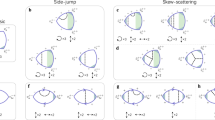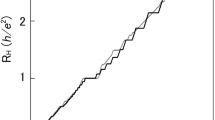Abstract
We discuss a model of both the classical and the integer quantum Hall effect which is based on a semiclassical Schrödinger-Chern-Simons action, where the Ohm equations result as equations of motion. The quantization of the classical Chern-Simons part of action under typical quantum Hall conditions results in the quantized Hall conductivity. We show further that the classical Hall effect is described by a theory which arises as the classical limit of a theory of the quantum Hall effect. The model also explains the preference and the domain of the edge currents on the boundary of samples.
Similar content being viewed by others
References
Callaway, J. (1964).Energy Band Theory, Academic Press, New York.
Dunne, G. V., and Treugenberger, C. (1989).Modern Physics Letters A,4, 1635–1644.
Dunne, G. V., Jackiw, R., and Treugenberger, C. (1989).Annals of Physics,194, 197–223.
Feynman, R. P., and Hibbs, A. R. (1965).Quantum Mechanics and Path Integrals, McGraw-Hill, New York.
Fröhlich, J., and Kerler, T. (1991).Nuclear Physics B,354, 369–417.
Ghaboussi, F. (n.d.-a). On the integer quantum Hall effect, quant-ph/9603011.
Ghaboussi, F. (n.d.-b). A model of the integer quantum Hall effect, quant-ph/9603012; submitted for publication.
Ghaboussi, F. (n.d.-c). In preparation.
Jackiw, R. (1990). InPhysics, Geometry, and Topology, H. C. Lee, ed., Plenum Press, New York.
Janssen, M.,et al. (1994).Introduction to the Theory of the Integer Quantum Hall Effect, J. Hajdu, ed., VCH-Verlag, Weinheim.
Knott, R., Dietsche, W., von Klitzing, K., Eberl, K., and Ploog, K. (1995).Semiconductor Science and Technology,10, 117–126.
Landau, L. D., and Lifschitz, E. M. (1976).
Macdonald, A. H., ed. (1989).Quantum Hall Effect: A Perspective, Kluver, Dordrecht.
Morandi, G. (1992).The Role of Topology in Classical and Quantum Physics, Springer, New York.
Prange, R. E., and Girvin, S. M., eds. (1987).The Quantum Hall Effect, Springer, New York.
Semenof, G. W. (1988).Physical Review Letters,61, 517.
von Klitzing, K. (1995).Physica B,204, 111–116.
Witten, E. (1989).Communications in Mathematical Physics,121, 351–399.
Zhang, S. C., Hansson, T. H., and Kivelson, S. (1989).Physical Review Letters,62, 82.
Author information
Authors and Affiliations
Rights and permissions
About this article
Cite this article
Ghaboussi, F. Quantum theory of the Hall effect. Int J Theor Phys 36, 923–934 (1997). https://doi.org/10.1007/BF02435792
Received:
Issue Date:
DOI: https://doi.org/10.1007/BF02435792




